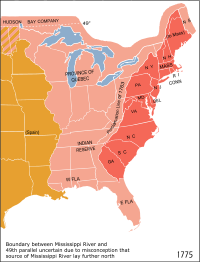From Wikipedia, the free encyclopedia
The Thirteen Colonies were part of what became known as British America, a name that was used by Great Britain until the Treaty of Paris recognized the independence of the original thirteen United States of America in 1783. These British colonies in North America rebelled against British rule in 1775, this was due to the taxation that Great Britain was imposing on the colonies. A provisional government was formed which proclaimed their independence, which is now celebrated as having occurred on July 4, 1776, and subsequently became the original thirteen United States of America. The colonies were founded between 1607 (Virginia), and 1733 (Georgia), although Great Britain held several other colonies in North America and the West Indies.
The Thirteen Colonies gave rise to 18 present-day states: the original 13 states (in chronological order: Delaware, Pennsylvania, New Jersey, Georgia, Connecticut, Massachusetts, Maryland, South Carolina, New Hampshire, Virginia, New York, North Carolina, Rhode Island), Vermont (which had been disputed between New Hampshire and New York and which was an independent republic from 1777 to 1791), Kentucky (formerly part of Virginia until 1792), Tennessee (formerly part of North Carolina until 1796), Maine (formerly part of Massachusetts until 1820), and West Virginia (also formerly part of Virginia until 1863).
[edit] Colonies

North American colonies 1763-76

In 1775, the British claimed authority over the red and pink areas on this map and
Spain ruled the orange. The red area is the area of the thirteen colonies open to settlement after the
Proclamation of 1763

Map of current US states that are direct
successor states of the original Thirteen Colonies that declared independence from Great Britain in 1776. Indirect successor states (
Maine,
West Virginia), the
District of Columbia and states that acceded to the union after the American Revolutionary War are not included
Contemporaneous documents usually list the thirteen revolutionary colonies of British North America in geographical order, from north to south.
[edit] Other divisions prior to 1730
- Dominion of New England
- Created by King James II with the consolidation of Maine, New Hampshire, Massachusetts Bay Colony, Plymouth Colony, Rhode Island, Connecticut, Province of New York, East Jersey, and West Jersey into a single larger colony in 1685. The experiment was discontinued with the Glorious Revolution of 1688-89, and the nine former colonies re-established their separate identities in 1689.
- Province of Maine
- Settled in 1622 (An earlier attempt to settle the Popham Colony on Sagadahoc Island, Maine in 1607 was abandoned after only one year). Massachusetts Bay colony encroached into Maine during the English Civil War, but, with the Restoration, autonomy was returned to Maine in 1664. Maine was officially merged into Massachusetts Bay Colony with the issuance of the Massachusetts Bay charter of 1691.
- Plymouth Colony
- Settled in 1620 by the Pilgrims. Plymouth was absorbed by Massachusetts Bay Colony with the issuance of the Massachusetts Bay charter of 1691.
- Saybrook Colony
- Founded in 1635 and merged with Connecticut Colony in 1644.
- New Haven
- Settled in late 1637. New Haven was absorbed by Connecticut Colony with the issuance of the Connecticut Charter in 1662, partly as royal punishment by King Charles II for harboring the regicide judges who sentenced King Charles I to death.
- East and West Jersey
- New Jersey was divided into two separate colonies in 1674. The Jerseys were reunited in 1702.
- Province of Carolina
- Founded in 1663. Carolina colony was divided into North Carolina and South Carolina in 1712. Both colonies became royal colonies in 1729.
[edit] Population
(Note: the population figures do not account for the native tribes who originally resided there.)
| Year |
Population |
| 1625 |
1,980 |
| 1641 |
50,000 |
| 1688 |
200,000 |
| 1702 |
270,000 |
| 1715 |
434,600 |
| 1749 |
1,046,000 |
| 1754 |
1,485,634 |
| 1765 |
2,240,000 |
| 1775 |
2,418,000
At the time of the Revolutionary War, approximately 85 per cent of the white population was of English, Irish, Welsh, and Scottish descent. Persons of German origin represented 8.8 per cent of the white population, and those of Dutch origin represented 3.5 per cent of the colonists.
|
[2]
[edit] See also
- ^ The present State of Vermont was disputed between the colonies of New York and New Hampshire. From 1777 to 1791, it existed as the de facto independent Vermont Republic.
- ^ Greene
[edit] References
- Cooke, Jacob Ernest et al., ed. Encyclopedia of the North American Colonies. Scribner's, 1993. 3 vol; 2397 pp.
- Gipson, Lawrence. The British Empire Before the American Revolution (15 volumes) (1936-1970), Pulitzer Prize; highly detailed discussion of every British colony in the New World
- Greene, Evarts Boutelle et al., American Population before the Federal Census of 1790, 1993, ISBN 0806313773
- Greene, Evarts Boutelle. Provincial America, 1690-1740. 1905. online
- Osgood, Herbert L. The American Colonies in the Seventeenth Century. 4 vol Columbia University Press, 1904-07. online
- Vickers, Daniel, ed. A Companion to Colonial America. Blackwell, 2003. 576 pp.







